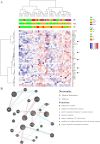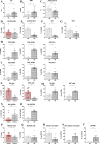Age-severity matched cytokine profiling reveals specific signatures in Covid-19 patients
- PMID: 33159040
- PMCID: PMC7646225
- DOI: 10.1038/s41419-020-03151-z
Age-severity matched cytokine profiling reveals specific signatures in Covid-19 patients
Abstract
A global effort is currently undertaken to restrain the COVID-19 pandemic. Host immunity has come out as a determinant for COVID-19 clinical outcomes, and several studies investigated the immune profiling of SARS-CoV-2 infected people to properly direct the clinical management of the disease. Thus, lymphopenia, T-cell exhaustion, and the increased levels of inflammatory mediators have been described in COVID-19 patients, in particular in severe cases1. Age represents a key factor in COVID-19 morbidity and mortality2. Understanding age-associated immune signatures of patients are therefore important to identify preventive and therapeutic strategies. In this study, we investigated the immune profile of COVID-19 hospitalized patients identifying a distinctive age-dependent immune signature associated with disease severity. Indeed, defined circulating factors - CXCL8, IL-10, IL-15, IL-27, and TNF-α - positively correlate with older age, longer hospitalization, and a more severe form of the disease and may thus represent the leading signature in critical COVID-19 patients.
Conflict of interest statement
The authors declare no competing interests
Figures






Similar articles
-
A single-cell atlas of the peripheral immune response in patients with severe COVID-19.Nat Med. 2020 Jul;26(7):1070-1076. doi: 10.1038/s41591-020-0944-y. Epub 2020 Jun 8. Nat Med. 2020. PMID: 32514174 Free PMC article.
-
Pro- and Anti-Inflammatory Responses in Severe COVID-19-Induced Acute Respiratory Distress Syndrome-An Observational Pilot Study.Front Immunol. 2020 Oct 6;11:581338. doi: 10.3389/fimmu.2020.581338. eCollection 2020. Front Immunol. 2020. PMID: 33123167 Free PMC article.
-
Using IL-2R/lymphocytes for predicting the clinical progression of patients with COVID-19.Clin Exp Immunol. 2020 Jul;201(1):76-84. doi: 10.1111/cei.13450. Epub 2020 May 15. Clin Exp Immunol. 2020. PMID: 32365221 Free PMC article.
-
Immune response to SARS-CoV-2 and mechanisms of immunopathological changes in COVID-19.Allergy. 2020 Jul;75(7):1564-1581. doi: 10.1111/all.14364. Allergy. 2020. PMID: 32396996 Free PMC article. Review.
-
SARS-CoV-2 infection: The role of cytokines in COVID-19 disease.Cytokine Growth Factor Rev. 2020 Aug;54:62-75. doi: 10.1016/j.cytogfr.2020.06.001. Epub 2020 Jun 2. Cytokine Growth Factor Rev. 2020. PMID: 32513566 Free PMC article. Review.
Cited by
-
Anti-Inflammatory Cytokine Profiles in Thrombotic Thrombocytopenic Purpura-Differences Compared to COVID-19.Int J Mol Sci. 2024 Sep 17;25(18):10007. doi: 10.3390/ijms251810007. Int J Mol Sci. 2024. PMID: 39337495 Free PMC article.
-
Immune system-related plasma extracellular vesicles in healthy aging.Front Immunol. 2024 Apr 3;15:1355380. doi: 10.3389/fimmu.2024.1355380. eCollection 2024. Front Immunol. 2024. PMID: 38633262 Free PMC article.
-
Potential marker subset of blood-circulating cytokines on hematopoietic progenitor-to-Th1 pathway in COVID-19.Front Med (Lausanne). 2024 Feb 27;11:1319980. doi: 10.3389/fmed.2024.1319980. eCollection 2024. Front Med (Lausanne). 2024. PMID: 38476443 Free PMC article.
-
The exploration of glucocorticoid pathway based on disease severity in COVID-19 patients.Heliyon. 2023 Dec 10;10(1):e23579. doi: 10.1016/j.heliyon.2023.e23579. eCollection 2024 Jan 15. Heliyon. 2023. PMID: 38187222 Free PMC article.
-
RAGE engagement by SARS-CoV-2 enables monocyte infection and underlies COVID-19 severity.Cell Rep Med. 2023 Nov 21;4(11):101266. doi: 10.1016/j.xcrm.2023.101266. Epub 2023 Nov 8. Cell Rep Med. 2023. PMID: 37944530 Free PMC article.
References
-
- Akbar AN, Gilroy DW. Aging immunity may exacerbate COVID-19. Science. 2020;369:256. - PubMed
MeSH terms
Substances
LinkOut - more resources
Full Text Sources
Miscellaneous

